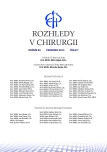SentiMag – the magnetic detection system of sentinel lymph nodes in breast cancer
Authors:
O. Coufal 1,2; V. Fait 1,2; E. Lžičařová 3; V. Chrenko 1; J. Žaloudík 2
Authors‘ workplace:
Oddělení chirurgické onkologie, Masarykův onkologický ústav, Brno, primář: MUDr. V. Chrenko, CSc.
1; Klinika komplexní onkologické péče, společné pracoviště Masarykova onkologického ústavu a Lékařské fakulty
Masarykovy univerzity, Brno, přednosta: prof. MUDr. R. Vyzula, CSc.
2; Oddělení patologie, Masarykův onkologický ústav, Brno, primář: MUDr. P. Fabian, Ph. D.
3
Published in:
Rozhl. Chir., 2015, roč. 94, č. 7, s. 283-288.
Category:
Original articles
Overview
Introduction:
The aim of this study was to assess the feasibility of the new detection system of sentinel lymph nodes in breast cancer (SentiMag) and to compare its use to the standard method of detection with a radioisotope and a gamma-probe.
Methods:
Twenty breast cancer patients scheduled for sentinel lymph node biopsy underwent standard lymphatic mapping with a radioisotope and also with the Sienna+ tracer. During the surgery, sentinel lymph nodes were identified preferably with the SentiMag system. The gamma-probe was used only at the end of the surgery to verify whether all sentinel lymph nodes had been harvested.
Results:
The sentinel lymph node was detected in all cases. Both methods agreed in 18 cases, i.e. the lymph node with the highest magnetic value ex vivo was the same node as the one with the highest radioactivity. A metastasis in the sentinel lymph node was found in three patients. It is very likely that with the sole use of the SentiMag system, the results would have been identical to those of using the standard method with a radioisotope and the gamma-probe.
Conclusion:
The new magnetic detection method of sentinel lymph nodes (SentiMag) is feasible and clinically comparable to the gold standard method of detection with a radioisotope and the gamma-probe in patients with breast cancer. The new method could find its use not only in hospitals where the department of nuclear medicine is not available but in all hospitals performing sentinel lymph node biopsies in breast cancer and possibly other types of cancer.
Key words:
breast cancer – sentinel node – sentinel lymph node biopsy – lymphoscintigraphy – SentiMag
Sources
1. Coufal O, Vrtělová P, Krsička P. Operace mízních uzlin u karcinomů prsu – současný pohled. Postgraduální medicína 2012;14 : 376−83.
2. Gatěk J, Hnátek L, Dudešek B, et al. Biopsie sentinelové uzliny u karcinomu prsu v klinické praxi. Rozhl Chir 2008;87 : 180−5.
3. Fait V. Sentinelová biopsie a možnosti využití v současné onkochirurgii. Klinická onkologie 2008;21 : 5−19.
4. Krag DN, Anderson SJ, Julian TB, et al. Sentinel-lymph-node resection compared with conventional axillary-lymph-node dissection in clinically node-negative patients with breast cancer: overall survival findings from the NSABP B-32 randomised phase 3 trial. http://www.ncbi.nlm.nih.gov/pubmed/20863759 Lancet Oncol 2010;11 : 927−33.
5. Brenet O, Lalourcey L, Queinnec M, et al. Hypersensitivity reactions to Patent Blue V in breast cancer surgery: a prospective multicentre study. Acta Anaesthesiol Scand 2013;57 : 106−11.
6. Chambon C, Clement O, Le Blanche A, et al. Superparamagnetic iron oxides as positive MR contrast agents: in vitro and in vivo evidence. Magn Reson Imaging 1993;11 : 509−19.
7. Thill M, Kurylcio A, Welter R, et al. The Central-European SentiMag study: sentinel lymph node biopsy with superparamagnetic iron oxide (SPIO) vs. radioisotope. Breast 2014;23 : 175−9.
8. Douek M, Klaase J, Monypenny I, et al. Sentinel node biopsy using a magnetic tracer versus standard technique: the SentiMAG Multicentre Trial. Ann Surg Oncol 2014;21 : 1237−45.
9. Rubio IT, Diaz-Botero S, Esgueva A, et al. The superparamagnetic iron oxide is equivalent to the Tc99 radiotracer method for identifying the sentinel lymph node in breast cancer. Eur J Surg Oncol 2015;41 : 46−51.
10. Johnson L, Pinder SE, Douek M. Deposition of superparamagnetic iron-oxide nanoparticles in axillary sentinel lymph nodes following subcutaneous injection. Histopathology 2013;62 : 481−6.
11. O´Reilly EA, Prichard RS, Al Azawi D, et al. The value of isosulfan blue dye in addition to isotope scanning in the identification of the sentinel lymph node in breast cancer patients with a positive lymphoscintigraphy: A randomized controlled trial (ISRCTN98849733). Ann Surg 2015; Mar 27. [Epub ahead of print]
12. Zapletal O, Coufal O, Selingerová I, et al. Počet odebíraných axilárních sentinelových uzlin a jeho vliv na diagnostickou přesnost sentinelové biopsie u karcinomu prsu. Rozhl Chir 2013;92 : 21−26.
13. Barranger E, Ihrai T. Response to the article by Thill et al. The Central-European SentiMag study: sentinel lymph node biopsy with supermagnetic iron oxide (SPIO) vs. radioisotope. The Breast 2014;23 : 297.
14. Thill M, Kurylcio A, Welter R, et al. Response to Barranger E, Ihrai T, response to the article by Thill et al. „The Central-European SentiMag study: Sentinel lymph node biopsy with supermagnetic iron oxide (SPIO) vs. radioisotope“. IN The Breast 2014, 23 : 175-9. Breast. 2014;23 : 692.
15. Motomura K, Ishitobi M, Komoike Y, et al. SPIO-enhanced magnetic resonance imaging for the detection of metastases in sentinel nodes localized by computed tomography lymphography in patients with breast cancer. Ann Surg Oncol 2011;18 : 3422−9.
Labels
Surgery Orthopaedics Trauma surgeryArticle was published in
Perspectives in Surgery

2015 Issue 7
Most read in this issue
- Pruritus ani
- SentiMag – the magnetic detection system of sentinel lymph nodes in breast cancer
- Heterotopic mesenteric ossification
- Endoscopic endonasal treatment of cerebrospinal fluid leak caused by clival fracture – a case report
